

从JS源码层面看node启动过程
source link: https://www.kingkk.com/2021/11/%E4%BB%8EJS%E6%BA%90%E7%A0%81%E5%B1%82%E9%9D%A2%E7%9C%8Bnode%E5%90%AF%E5%8A%A8%E8%BF%87%E7%A8%8B/
Go to the source link to view the article. You can view the picture content, updated content and better typesetting reading experience. If the link is broken, please click the button below to view the snapshot at that time.

为什么要写“从JS源码层面”呢,因为众所周知,node是由C++赋予了其控制操作系统的能力,因此node服务本身自然也是从C++层面开始启动,但本文目前暂不涉及C++相关内容,仅从JS代码层面来看下node服务的启动过程。主要是为了弄清主模块的加载、require导入模块的加载 以及preload模块的加载过程。三个文件的代码如下。
// index.js
require("./load")
console.log("hello world")
// load.js
console.log("load")
// preload.js
console.log("preload")
通过node -r ./preload ./index.js即可得到如下输出
preload
load
hello world
一个比较直观的感受就是先加载的preload模块,然后在加载index.js时加载了load.js,最后执行完index.js。本文的测试以及调试的node源码版本均为v12.13.0
runMain
故事的开始从internal/main/run_main_module.js文件开始
可以看到最开始先执行了prepareMainThreadExecution这个函数,做一些主线程的启动前的准备工作,其实preload模块的加载也在其中,但目前先按下不表,先分析主模块的加载过程,后面再来看这个preload模块的加载。
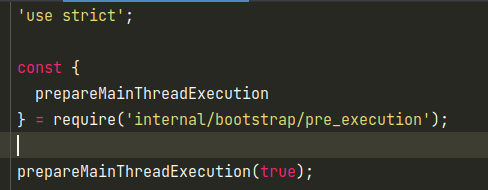
然后就是加载internal/modules/cjs/loader模块,这里主要是CJSModule的模块加载过程,高版本的node可以支持CommonJS和ESModule两种不同的语法类型,默认是选用CommonJS
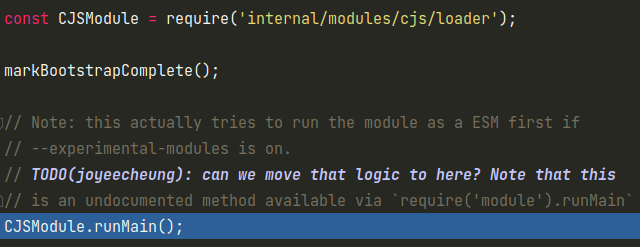
require('internal/modules/cjs/loader')模块中也执行了一部分代码,主要是一些Module类的初始化工作,以及一些函数定义,这里就先不细讲,主要来看下后面runMain函数中的内容。
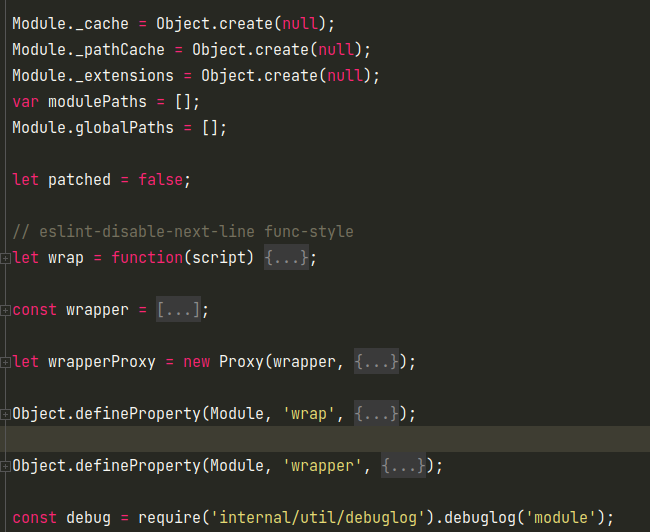
一开始是一些实验性模块的判断,对应--experimental-modules参数,用于开启一些特性
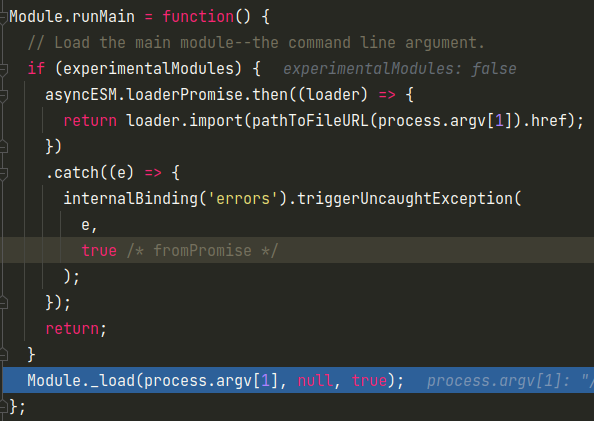
然后就是进入Module._load函数,这是一个递归函数,三个参数分别代表要加载的文件名、caller和是否是main文件。
其作用引用下注释中的话便比较容易懂了
Check the cache for the requested file.
- If a module already exists in the cache: return its exports object.
- If the module is native: call
NativeModule.prototype.compileForPublicLoader()and return the exports.- Otherwise, create a new module for the file and save it to the cache.
Then have it load the file contents before returning its exports
object.
就是如果Module的cache中已经存在对应的要加载的文件,则直接return exports对象。
const filename = Module._resolveFilename(request, parent, isMain);
const cachedModule = Module._cache[filename];
if (cachedModule !== undefined) {
updateChildren(parent, cachedModule, true);
return cachedModule.exports;
}
如果模块是一个native模块,则调用NativeModule.prototype.compileForPublicLoader() 然后返回其exports。
const mod = loadNativeModule(filename, request, experimentalModules);
if (mod && mod.canBeRequiredByUsers) return mod.exports;
如果都不是,则就是正经首次加载模块的过程
如果main模块,则设置process.mainModule为当前模块名,并且设置module.id为.
if (isMain) {
process.mainModule = module;
module.id = '.';
}
然后会将module放入Module._cache中,并且在relativeResolveCache中缓存对应的文件名,并且如果最后load模块失败时会从缓存中删除对应的cache,从而保证了文件加载时不会产生无限递归的加载。
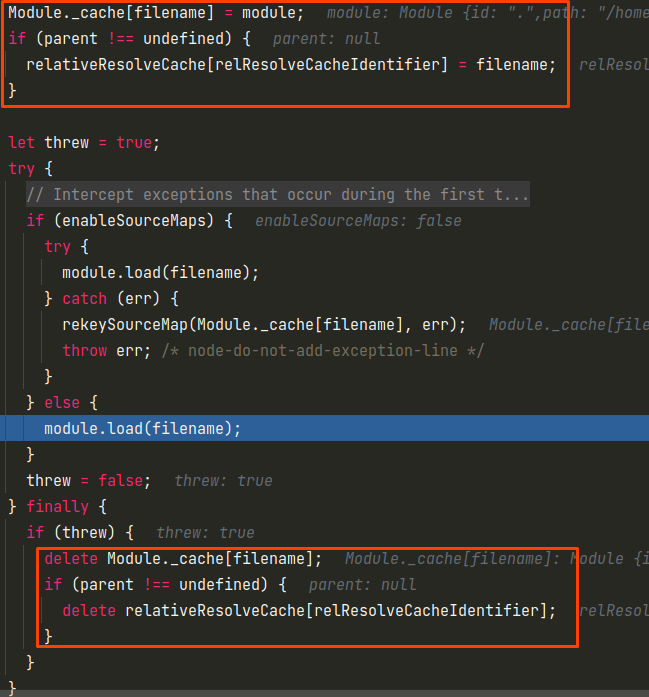
然后就是核心的module.load方法,根据文件名后缀调用不同的加载器
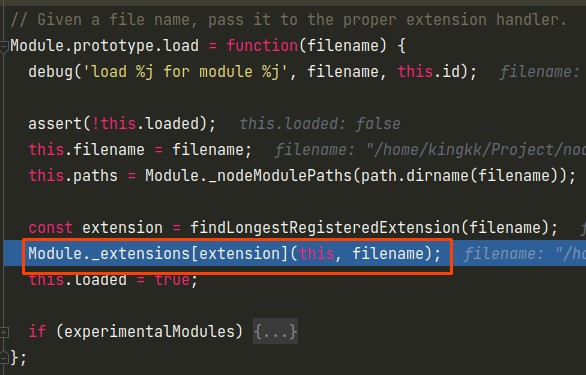
可以看到默认支持如下四个文件类型,这里主要来看下正常的.js的加载器
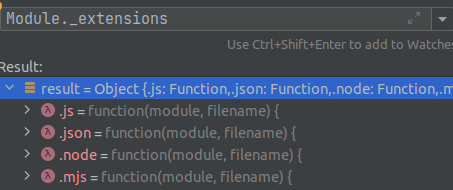
前面是一些future模块的特性,可以先跳过,然后就是读取文件内容,去掉BOM头,调用module._compile进行编译
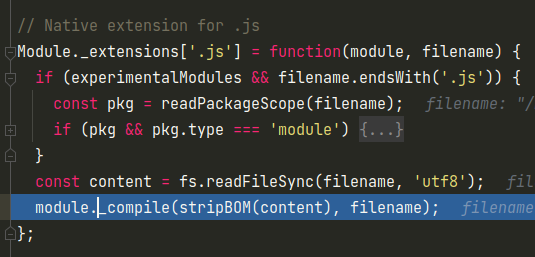
根据Module.prototype._compile的注释可以看出,我们编写的node代码会在一个对应的scope或者沙箱中运行,并且向其中暴露一些变量,如require、module、exports,我们也能知道这就是node中默认提供的一些内置函数。
Run the file contents in the correct scope or sandbox. Expose the correct helper variables (require, module, exports) to the file. Returns exception, if any.
前面是一些stripShebang和处理cache sourcemap相关的逻辑,可以先跳过。
如果是patched模式,则通过vm.runInThisContext在沙箱中运行代码。
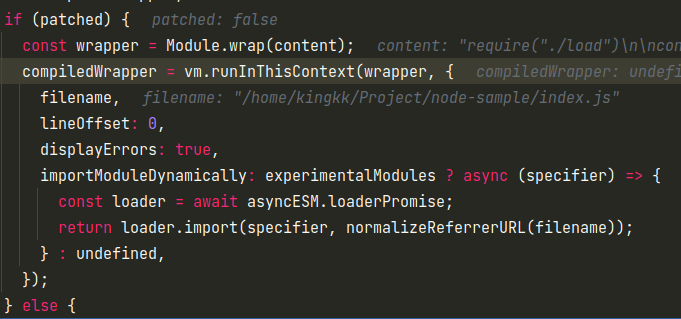
默认情况会进入else分支,则会创建一个函数,可以看到几个熟悉的内置变量名exports、require、module、__filename、__dirname。
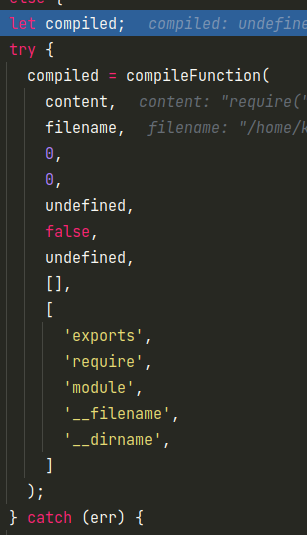
可以先不用管函数的具体生成方式,直接来看下生成的函数,即可知道其作用
function (exports, require, module, __filename, __dirname) {
require("./load")
console.log("hello world")
}
可以看到其实做的仅是将我们的代码被被套入到了一个函数中,这也是node的js代码的实际运行方式。
然后其实就是获取到要传入这几个变量,调用这个生成的函数即可。dirname和filename就是对应的文件名没什么好说的,require变量默认情况就是module.require方法,exports和和module则分别就是this.exports和this了。
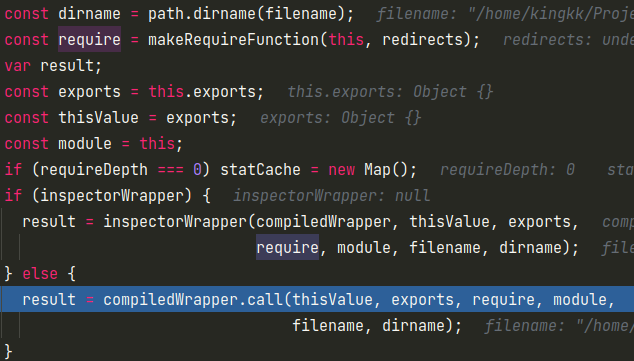
然后调用这个compiledWrapper.call就会执行我们编写的js文件了。
require module
然后我们的index.js中调用了require("./load"),之前说过,默认情况下require其实就是module.require函数。
简单的校验下传入的id,然后记录下require的深度,就会继续调用Module._load函数
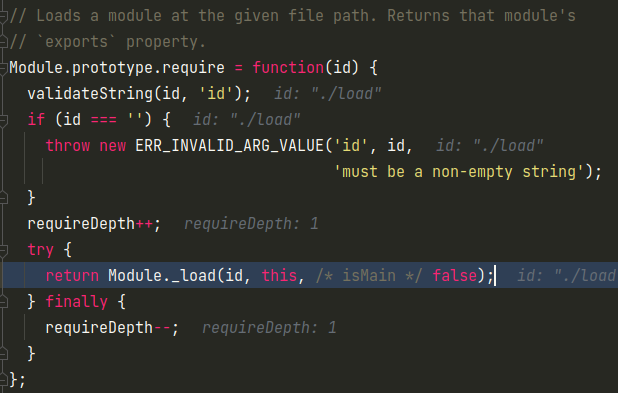
但是这回的区别在于传入的函数,parent原本为null,如今则是caller的模块,isMain也设置为了false。
这里parent为true与之前不同的便是这个缓存的机制,但其实也类似,便是如果Module._cache中存在了对应缓存则直接返回,否则和之前和load的逻辑一致,然后调用.js加载器,最后将源文件封装成一个compiledWrapper并执行。
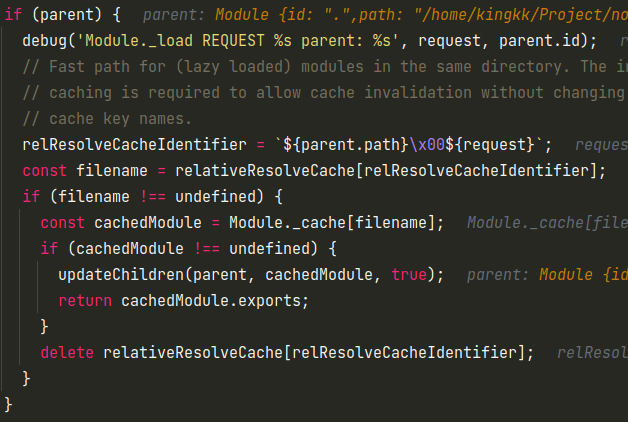
然后当还有require没加载过的模块时便会这样一致递归加载,直到当前模块所递归引用到的所有模块都加载完成之后依次退出,最后就完成了整个node文件的启动过程。
这整个过程都是同步的,后面执行的代码则是注册在事件循环中函数了。
preload
preload的加载过程则是在一开始的run_main_module的prepareMainThreadExecution中
其中做了许多init的东西,例如熟悉的inspector、自定义异常堆栈处理、CJS和EMS的模块初始化等,这里就不展开讲了。
然后就是loadPreloadModules函数的处理,根据-r参数的值,预处理对应的模块
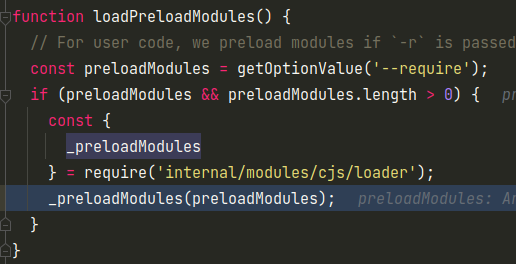
然后就到了Module._preloadModules模块中,需要注意的就是这里会设置parent为internal/preloadmodule,然后依次for循环-r参数的文件列表,进行require加载。
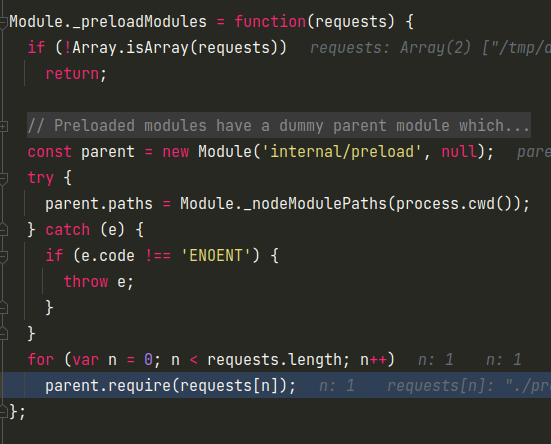
后面的过程就是Module.prototype.require和之前require模块的过程一样了。
这样我们就可以通过preload机制在主程序运行前进行一些预加载的处理机制。
References
Recommend
About Joyk
Aggregate valuable and interesting links.
Joyk means Joy of geeK